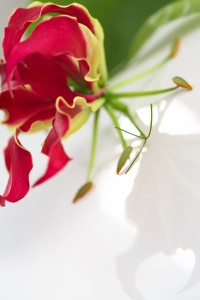Gloriosa
 Gloriosa Rothschildiana is more commonly known as the Gloriosa Lily or Glory Lily from the latin gloria meaning honour, fame. This splendid and exotic lily was named after Baron Z.W. Rothschild, an authority on birds, who brought the flower from Africa and entered it at an exhibition of the English Horticultural Society at the turn of the century.
Gloriosa Rothschildiana is more commonly known as the Gloriosa Lily or Glory Lily from the latin gloria meaning honour, fame. This splendid and exotic lily was named after Baron Z.W. Rothschild, an authority on birds, who brought the flower from Africa and entered it at an exhibition of the English Horticultural Society at the turn of the century.
Description
Gloriosa can reach up to eight feet in length and, depending on variety, they often produce vivid flowers in bright yellow, orange, or even crimson shades. The shapes of the flowers can vary, from wavy petals and ones with a green tinge to slender petals as found in Lutea.
Habitat
This genus is native to South Africa’s Cape Province, although today it can be found growing in the tropical regions of Asia, as well as more northerly regions of Africa.
Availability
Summer is the best time of year for flowering and the ideal conditions for Gloriosa are either dormant dry periods or wet summers.
Species
There are seven known species of Gloriosa, including the G. rothschildiana variety of flame lily with its whorled leaves and flame-like flowers. Also of note are the G. simplex with its bright orange and yellow flowers and the G. superba var. Lutea with its pure yellow petals.
Care Tips
High temperatures are the key to keeping Gloriosa plants in good condition. They require night-time temperatures of around 20C and daytime temperatures of around 22-25C to stay healthy. It’s best to plant them in acidic/neutral soil that’s fast-draining, with considerable access to shade. Watering and feeding during the blooming period is very important.
Did You Know?
In parts of Africa and Asia, Gloriosa is sometimes used as a herb for cooking and, in some cases, for medicine.
References
http://www.botany.com/gloriosa.html


